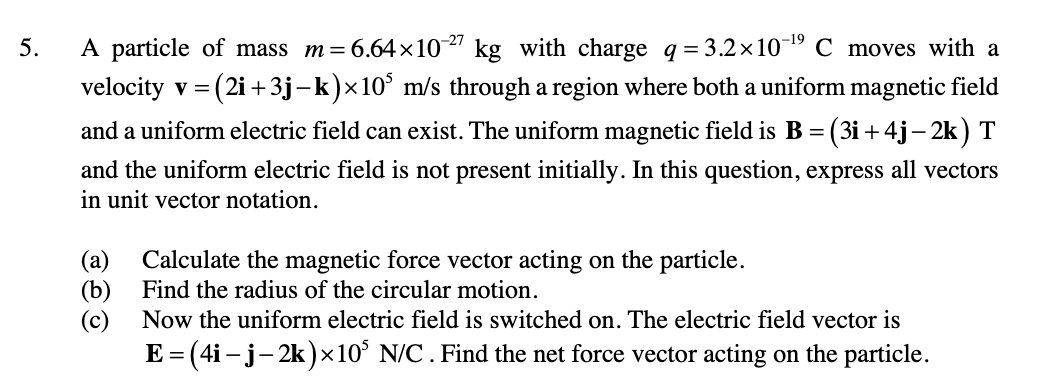A particle of mass \(m = 6.64 \times 10^{-27}\) kg with charge \(q = 3.2 \times 10^{-19}\) C moves with a velocity \(v = (2i + 3j - k) \times 10^5\) m/s through a region where both... A particle of mass \(m = 6.64 \times 10^{-27}\) kg with charge \(q = 3.2 \times 10^{-19}\) C moves with a velocity \(v = (2i + 3j - k) \times 10^5\) m/s through a region where both a uniform magnetic field and a uniform electric field can exist. The uniform magnetic field is \(B = (3i + 4j - 2k)\) T and the uniform electric field is not present initially. In this question, express all vectors in unit vector notation. (a) Calculate the magnetic force vector acting on the particle. (b) Find the radius of the circular motion. (c) Now the uniform electric field is switched on. The electric field vector is \(E = (4i - j - 2k) \times 10^5\) N/C. Find the net force vector acting on the particle.

Understand the Problem
The problem describes a charged particle moving through magnetic and electric fields. It asks us to: (a) Calculate the magnetic force acting on the particle. (b) Find the radius of the circular motion of the particle due to magnetic force. (c) Find the net force on the particle when an electric field is also present. These are physics problems that require applying the formulas for magnetic and electric forces on moving charges.
Answer
(a) $F_B = (-6.4i + 3.2j - 3.2k)\times10^{-14}$ N (b) $r \approx 1.75\times10^{-4}$ m (c) $F_{net} = (6.4i - 9.6k)\times10^{-14}$ N
Answer for screen readers
(a) The magnetic force vector is $F_B = (-6.4i + 3.2j - 3.2k)\times10^{-14}$ N. (b) The radius of the circular motion is approximately $r \approx 1.75\times10^{-4}$ m. (c) The net force vector is $F_{net} = (6.4i - 9.6k)\times10^{-14}$ N.
Steps to Solve
- Calculate the magnetic force
The magnetic force on a charged particle is given by the formula: $$ F_B = q(v \times B) $$ where $q$ is the charge, $v$ is the velocity vector, and $B$ is the magnetic field vector. We need to compute the cross product $v \times B$.
Given $v = (2i+3j-k)\times10^5$ m/s and $B = (3i + 4j-2k)$ T, we calculate the cross product as follows:
$$ v \times B = \begin{vmatrix} i & j & k \ 2\times10^5 & 3\times10^5 & -1\times10^5 \ 3 & 4 & -2 \end{vmatrix} $$
$$ v \times B = i[(3\times10^5)(-2) - (-1\times10^5)(4)] - j[(2\times10^5)(-2) - (-1\times10^5)(3)] + k[(2\times10^5)(4) - (3\times10^5)(3)] $$
$$ v \times B = i[-6\times10^5 + 4\times10^5] - j[-4\times10^5 + 3\times10^5] + k[8\times10^5 - 9\times10^5] $$
$$ v \times B = -2\times10^5 i + 1\times10^5 j - 1\times10^5 k $$
Now, multiply by the charge $q = 3.2\times10^{-19}$ C:
$$ F_B = (3.2\times10^{-19}) (-2\times10^5 i + 1\times10^5 j - 1\times10^5 k) $$
$$ F_B = (-6.4i + 3.2j - 3.2k)\times10^{-14} \text{ N} $$
- Find the radius of the circular motion
The magnetic force causes the particle to move in a circular path. The magnetic force provides the centripetal force, so $F_B = \frac{mv^2}{r}$, where $r$ is the radius of the circle. However, since the velocity is not perpendicular to the magnetic field, we need to find the component of velocity perpendicular to the magnetic field, $v_{\perp}$. And we will use $F_B = q v_{\perp} B$, where $B$ is the magnitude of the magnetic field. Then, $qv_{\perp}B = \frac{mv_{\perp}^2}{r}$, therefore $r = \frac{mv_{\perp}}{qB}$.
First, we find the magnitude of the velocity: $|v| = \sqrt{(2\times10^5)^2 + (3\times10^5)^2 + (-1\times10^5)^2} = \sqrt{4+9+1}\times10^5 = \sqrt{14}\times10^5$ m/s Then, we find the magnitude of the magnetic field: $|B| = \sqrt{3^2 + 4^2 + (-2)^2} = \sqrt{9+16+4} = \sqrt{29}$ T Then, we use the magnetic force magnitude that we previously calculated: $|F_B| = \sqrt{(-6.4\times10^{-14})^2 + (3.2\times10^{-14})^2 + (-3.2\times10^{-14})^2} = \sqrt{40.96+10.24+10.24}\times10^{-14} = \sqrt{61.44}\times10^{-14} \approx 7.84\times10^{-14}$ N
We have $|F_B|=q v_{\perp} B$, so $v_{\perp} = \frac{|F_B|}{q|B|} = \frac{7.84\times10^{-14}}{(3.2\times10^{-19})(\sqrt{29})} = \frac{7.84\times10^5}{3.2\sqrt{29}} \approx 4.55\times10^4$ m/s
Now we can calculate the radius: $r = \frac{mv_{\perp}}{qB} = \frac{(6.64\times10^{-27})(4.55\times10^4)}{(3.2\times10^{-19})(\sqrt{29})} = \frac{3.02\times10^{-22}}{1.72\times10^{-18}} \approx 1.75\times10^{-4}$ m
- Calculate the net force with the electric field
The electric force on the particle is given by: $$ F_E = qE $$ where $E = (4i-j-2k)\times10^5$ N/C. So, $$ F_E = (3.2\times10^{-19}) (4i-j-2k)\times10^5 = (12.8i - 3.2j - 6.4k)\times10^{-14} \text{ N} $$
The net force is the sum of the magnetic and electric forces: $$ F_{net} = F_B + F_E = (-6.4i + 3.2j - 3.2k)\times10^{-14} + (12.8i - 3.2j - 6.4k)\times10^{-14} $$
$$ F_{net} = (12.8 - 6.4)i + (3.2 - 3.2)j + (-3.2 - 6.4)k \times10^{-14} $$
$$ F_{net} = (6.4i + 0j - 9.6k)\times10^{-14} \text{ N} $$
(a) The magnetic force vector is $F_B = (-6.4i + 3.2j - 3.2k)\times10^{-14}$ N. (b) The radius of the circular motion is approximately $r \approx 1.75\times10^{-4}$ m. (c) The net force vector is $F_{net} = (6.4i - 9.6k)\times10^{-14}$ N.
More Information
The cross product of vectors $v$ and $B$ results in a vector perpendicular to both $v$ and $B$. This perpendicularity leads to circular motion when only a magnetic field is present. When an electric field is introduced, the net force is the vector sum of the magnetic and electric forces.
Tips
-
Incorrect Cross Product Calculation: A common mistake is making errors in calculating the cross product of the velocity and magnetic field vectors.
-
Forgetting to Convert Units: Ensure all quantities are in SI units before performing calculations.
-
Misunderstanding Vector Addition: When calculating the net force, remember to add the force vectors component-wise, not just their magnitudes.
AI-generated content may contain errors. Please verify critical information